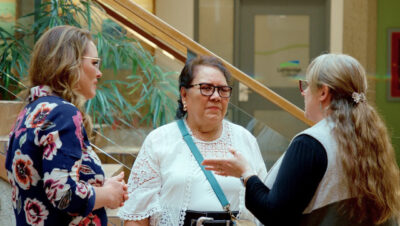College research project to support marginalized populations
By Alejandra Pulido-Guzman - Lethbridge Herald on December 21, 2023.
 Lethbridge College photo
Project director Kirsten Fantazir, Ninastako Cultural Centre executive director Gloria Wells and researcher Jami Albright-Tolman are part of a new research project using art and Blackfoot world-views to support marginalized populations.
Lethbridge College photo
Project director Kirsten Fantazir, Ninastako Cultural Centre executive director Gloria Wells and researcher Jami Albright-Tolman are part of a new research project using art and Blackfoot world-views to support marginalized populations.LETHBRIDGE HERALDapulido@lethbridgeherald.com
The Lethbridge College has received a significant federal grant that will be disbursed over three years for a new research project using art and Blackfoot world-views to support marginalized populations as they reintegrate into the community.
The research project is called the Community Integration through Art – Pissatsinaskssini, (CITAP) Program. This project is being funded by a College and Community Social Innovation Fund grant, which is a joint Natural Sciences and Engineering Research Council of Canada and Social Sciences and Humanity Research Council of Canada grant for $360,000 over the three-year life of the project.
Instructor in the school of justice studies and researcher of CITAP program, Jami Albright-Tolman told the Herald Wednesday the project is being developed in partnership with the Ninastako Cultural Centre (NCC).
“We will design, implement, and evaluate a social recreational peer support group that will use art and Blackfoot world-views to support marginalized populations with community integration,” said Albright-Tolman.
She said the grant has allowed them to hire two student research assistants, one from the Lethbridge College and one from the University of Lethbridge, and a student web developer who is a current college student, to work on the project and to help with both the research and the development of the website.
“The CITAP program will host support group meetings twice per month that will include creating art, sharing food, building relationships, and learning about health and wellbeing in an environment guided by Blackfoot knowledge,” said Albright-Tolman.
She said each meeting will involve a member of the research team, an artist or craftsperson, participants and at least one of the following: an Elder, a knowledge keeper, a health or wellness professional, or a service organization representative.
“Through casual conversation while working on art projects, we will share knowledge to improve the health and wellness of all participants. The program is open to everyone regardless of race or ethnicity, but there will be a focus on Blackfoot culture, language, knowledge, and world-views in every meeting,” said Albright-Tolman.
She said they are also incorporating Indigenous research methods into the design and evaluation of the program, with the Blackfoot culture, language, and knowledge pieces guided directly by the NCC and the artists, Elders, and knowledge keepers the NCC works with.
“The overarching goal of this program is to support and encourage the integration of marginalized people who feel they aren’t connected to the community in a meaningful way. They may be marginalized by circumstance, race, ethnicity or ability. We are not limiting that marginalization in any way,” said Albright-Tolman.
She said the goal is to help them feel more connected while simultaneously working to break down barriers between Indigenous and non-Indigenous peoples and cultures.Â
“The idea is that we will all sit together and will eat and will make our art guided by an artist volunteer to teach us, and then we’ll talk about something that is relevant to folks’ lives. We’ll tell them maybe about a service that Streets Alive provides for free, or we will talk about a health issue that is particularly relevant to some of the marginalized populations that are represented in the group,” said Albright-Tolman.
 She said the program basically helps “flip the script” within the group attending, as for many years western world views have been imposed on them as being the way to do things.
“Now we’re going to say whether you’re Indigenous or not, the Indigenous way of knowing and the indigenous worldview, specifically here because of our local context, the Blackfoot worldview, is the way to do things. So let’s have the Blackfoot worldview permeate this group regardless of your own ethnic or racial background,” said Albright-Tolman.
Project director and president’s applied research chair Kirsten Fantazir said the original idea for the CITAP program was well received by the NCC as they have yet to focus on the marginalized groups and they were more than happy to do so.
 “When we presented this to Gloria Wells, the executive director of the Ninastako Cultural Centre, she said the Ninastako Cultural Centre is already doing a lot of this work with a larger group of people, but they haven’t necessarily focused on the marginalized groups, and that’s when Gloria was quite excited, because now it would be tapping into and providing some of the resources that they are already providing,” said Fantazir.
She said in terms of the research side of the program, one of the goals is to help collect information about what marginalized people need for the program to be beneficial to them.
“The first phase of the project though, that we’re in right now, is really to find out what do the people that we want to come to these meetings want. We want to ask them, we don’t want to assume, and I think that’s the difference from previous programming or research that’s been done, where usually there’s a group of people saying, ‘this is what you need’. We really wanted to come from the people that we’re trying to get to come to the meeting,” said Fantazir.
She said another part of their involvement is to collect data, which will be beneficial for the NCC in the future to be able to apply for grants to continue the program.
“What we’re looking to do from the research angle is help to justify what’s happening. Hopefully we can show that we are benefiting their priority population and that will help them as large funding agencies are evidence- based, and they want to see the data, what is this doing. It can’t just be people saying it’s beneficial, they want something more. That’s where we are hoping to help, to bring that evidence piece so that they can continue doing the work,” said Fantazir.
Follow @APulidoHerald on Twitter
23-22




